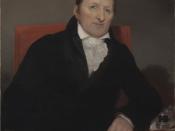During the 1800s, the United States economy grew dramatically due to new inventions, remarkably rapid growth, and new forms of communication and transportation. These benefits brought about changes to the workforce as well. These newly discovered inventions, created more manufacturing purposes and brought about more jobs in different industries. This was a time known as the Industrial Revolution.
Throughout the industrial revolution, inventors like Thomas Alva Edison greatly increased the quality of life for all Americans with inventions of the light bulb, phonograph, motion picture, electric power plant, any many more. Samuel Morse proved that signals could be transmitted by wire. He used pulses of current to deflect an electromagnet, which moved a marker to produce written codes on a strip of paper - the invention of Morse Code. Eli Whitney was the inventor of the cotton gin and a pioneer in the mass production of cotton.
The American Revolution created a great change in the colonies in the mid to late 1700's.
Gordon S. Wood's, The Radicalism of American Revolution explains not only a change in the government of the colonies, but in society itself. "Such a change marked a real and radical revolution, a change of society, not just of government." (Wood, pg. 169) People no longer saw themselves as subjects dependant, was servile." (Wood, pg. 179) The American Revolution changed the views of the colonists, a change which embodied the spirit of the United States that would be felt for years to come.
In the early to mid 1800's, trade unions were divided by sexes--some even based on skill. Until the First World War and the formation of one union to represent all the needs of the industry, women were virtually absent from the ranks of the craft trade unions. In 1874 Emma Paterson founded the Women's...


